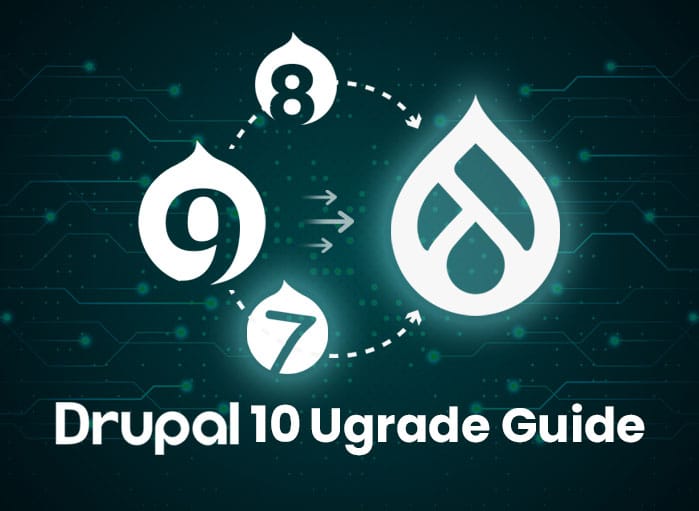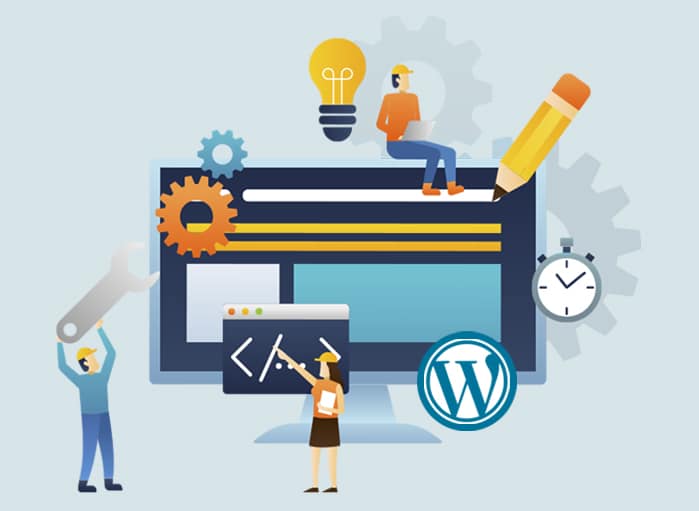
Everything To Know About Upgrading to Drupal 10
Tags: Drupal 10,Upgrade
eWay Corp November 23, 2022 7 MIN READ

Are you planning to give your site an upgrade to Drupal 10?
If you said – Yes, you have made the right decision. With Drupal going through a major version upgrade, this web platform is going to be a game-changer for developers. Simply because this new upgrade to Drupal 10 will bring to the table lots of new features that will surely enhance the overall web experience of the users.
So, before you go ahead and upgrade to Drupal 10, make sure you are aware of this upcoming version and its new features.
Drupal 10: Understand the Platform
You might know Drupal 10 (D10) is scheduled for an official release on 14th December 2022. Obviously, the entire Drupal community is excited about it. Why?
This latest version will represent some major changes to the platform that will be beneficial for everyone, such as developers, site builders, and even for content managers and creators.
However, some of you might feel that Drupal 9 (D9) is just two and a half years old; hence, going for another major version does not make any sense. This might seem an obvious thing, but the upgrade is necessary.
Obviously, the key reason behind the Drupal 10 update is to remain more committed to the values of the open web. This was clear from the Drupal 10 Readiness Initiative strategy. Also, the recent changes brought to the platform’s vision which specifies that this web platform is meant for site builders.
Since the past versions gave high priority to backward compatibility, making the upgradation process for the updated websites a very easy one. So, obviously, developers and site owners are eager to upgrade their existing sites to Drupal 10 as it will offer them a host of benefits.
Understanding the Drupal 10 Features
If you are on an old Drupal version, then you are going to miss some interesting features that the latest version of Drupal will bring about. In fact, the improved features of Drupal 10 will make it a stand-out option within the Drupal community.
Without dillydallying, let us take a quick look into the much-coveted Drupal 10 features. They are:
1. Claro Replacing Seven
Drupal 10 is going to support a new administrative theme called Claro. It is designed in accordance with industry standards and takes full advantage of the capabilities offered by the latest version of the CMS.
2. Olivero Replacing Bartik
Another Drupal 10 feature is the Olivero front-end theme. With this theme, users can take advantage of the new system’s capabilities and work with features like Layout Builder. It also allows the use of some of the common Drupal functionalities, such as embedded media, second-level navigation, and more.
3. New JavaScript Components
In Drupal 10, one will get to see modern JavaScript components; yet, using some of the jQuery functions. So, in the latest version, older libraries are replaced with new ones.
4. CKEditor 5 Replacing CKEditor 4
Another interesting Drupal 10 feature is going to be the new WYSIWYG editor. In other words, the CKEditor 5 is going to simply enhance the authoring experience of Drupal 10. This editor tool will come with certain improvements within the core CKEditor.
5. New Starterkit Theme
The Drupal 10 feature that should not be overlooked is the New Starter Kit theme. This theme will change the way developers create themes within Drupal. With this theme, the issues of subthemes will be completely removed.
6. Symfony 6 Replacing Symfony 4
Another biggest update and Drupal 10 feature are the move from Symfony 4 to Symfony 6. The 6th version of Symfony comes with the latest enhancement that can keep the Drupal system secure.
These are some of the interesting Drupal 10 features that are worth taking note of. Hopefully, now you will get to know why upgrade to Drupal 10 is gaining so much importance.
Drupal 9 to Be Used for Drupal 10
Drupal is an open web platform, empowers users so that they can curate their own web experience. For a long time, Drupal remained committed to inclusivity and accessibility.
But now it is even more focused on making it appealing to non-technical people and even those who are new in the world of development. Plus, the platform aims to become more user-friendly due to its useful features and enhancements.
Drupal 10 is going to be built on Drupal 9. Although the new Drupal upgrade is going to come with new features, all modifications will be compatible with the Drupal 9.4.0 version. This will allow the developers to keep up with all the probable API (Application Programming Interface) updates.
Drupal 10: Why Upgrading to The Latest Version Is So Important?
Delivering an impeccable digital experience to customers is the need of the hour. This is applicable to all businesses. With the advancement of technology, processes are either getting digitized or getting automated. Everything is shifting to the cloud. Plus, the users are more digitally conscious.
Since the pandemic, a greater number of users have shifted toward digital channels to carry out different tasks. Starting from purchasing groceries to ordering food, booking a restaurant to train ticket reservation, or even any kind of banking services are done online or through apps.
According to a study, more than 80% of customers prefer to carry out any kind of task digitally as it is safe and convenient for them. With businesses promising their customers a seamless digital experience, customers are ready to go onboard and experience digital transformation.
For this very reason, businesses should remain ready to offer a great customer experience. This requires building secure and feature-rich websites and robust mobile apps that can deliver an immersive experience to the users. Only then can a business stay ahead of the competition.
So, when the question of providing a great digital experience pops up, Drupal is highly trusted. It is one of the CMSs that offers the digital experience that users usually look for. With power-packed features, user-friendly UI (User Interface), and an elevated level of functionality, Drupal remains the best choice for CMS.
There is no denying that businesses need innovative solutions and technical upgrades for updating and upscaling any platforms, software, and websites. Migrating to the latest version can speed up or improve the digital performance of any software or website. Plus, it serves as an effortless way to offer reliable and optimized content on the web. In other words, by upgrading to the latest version, businesses can offer a seamless experience to customers for all platforms.
Why Drupal 10 Release Got Delayed?
The Drupal 10 release got pushed from June to August and then to December. This is for some good reason. Due to the delay, the latest version has seen continuous innovations.
In a similar manner, the delay made room for some major upgradation. For example, the latest version will now come with numerous third-party integrations and technologies that developers were always looking forward to.
For instance, the latest version will come with some integrated elements, like GitLab Acceleration, Decoupled Menus, Project Browser, and more. Also, releasing the updated version in December allowed the Drupal community to fix the bugs and offer a stable version to the end users.
Similarly, the applications on which Drupal is based needed some significant updates. The December release will give some time for the applications to have some version upgrades also. For instance, Drupal depends on PHP, Symfony, Composer, and many more applications. Upgrading the versions of these applications and elements will improve the web and mobile experience for the users.
Since the latest version of Drupal is going to support PHP 8.1, CKEditor 5, and Symfony 6; hence, making it a mandatory thing for Drupal 8 or 9-based websites to upgrade to Drupal 10. Plus, some components of Drupal will reach their End of Life (EOL) by early or late next year. Therefore, upgrading to the updated version Of Drupal is always a wise thing to do.
Why Upgrade to Drupal 10 is Inevitable?
The most important reason for the upgrade is that most of the dependencies of Drupal 8 or 9 will end. In other words, Drupal 8 or 9 relies on third-party components, such as CKEditor, PHP, Symfony, and Composer. Most of these third-party components will reach their End of Life by (EOL) in 2023.
For instance, the CKEditor is going to reach its EOL in 2023. Similarly, Drupal 9 relies on Symfony 4 which is going to reach its End of Life in November 2023. So, upgrading Symfony 4 to its latest version, i.e., Symfony 6 will not only align with the Drupal 10 component requirements but will also ensure that it works properly.
Likewise, Drupal 9 will reach its EOL by 2023 November. Hence, sites that are using Drupal 9 must upgrade to Drupal 10 eventually.
It is important to keep in mind that, once the third-party components or any older Drupal versions reach their end of life, they will cease to function. For this reason, upgrading the components, as well as the web platform to their advanced versions is mandatory.
For example, CKEditor 4 is getting an upgrade to CKEditor 5, Symfony 4 is going to be upgraded to Symfony 6.
How to Prepare & Upgrade to Drupal 10?
Drupal 10 release is scheduled for 14th December 2022. It is now official!
If you are currently on Drupal 7 or Drupal 8, it is recommended that you first upgrade to Drupal 9 and then upgrade to Drupal 10. However, if you are on Drupal 9, you can upgrade to D10 any time after its release. This is because Drupal 10 will share the same structure as Drupal 9.
However, the transition to Drupal 10 is not going to be extremely hard for the developers. We will take you through the steps for upgrading to D10 from other versions.
Drupal 9 Upgradation
Drupal 9’s EOL is in November 2023. After its EOL, Drupal 9 users will not receive any security or bug updates from the Drupal community. The EOL of Drupal 9 will also bring about the EOL for CKEditor 4 and Symfony 4.
Since the lifecycle of D9 will overlap with D10, Drupal 9 users will get enough time to review the latest version of Drupal and plan the switch accordingly.
Moreover, with each major Drupal version release, the platform gets more user-friendly. Also, certain Drupal 9 features make the process of migrating to Drupal 10 extremely easy.
In other words, the upgrade to Drupal 10 from Drupal 9 is going to be smooth.
Steps to Follow for Upgrading Drupal 9
If you are on Drupal 9, ensure your site is running on the latest minor version, i.e., 9.4.8 or 9.5. Once the Drupal 10 release takes place, you can simply follow the mentioned process.
- First, make sure to update the contrib modules.
- Second, you should completely remove the deprecated code from the custom themes and modules.
- Third, make sure to update the core.
For the upgrade to Drupal 10, some automated tools that can check for deprecated codes are:
- Drupal-Check
- Upgrade Status Contributed Module
Similarly, the Drupal Rector tool helps to fix the codes.
Drupal 8 Upgradation
Drupal 8 already met its end of life in November 2021. So, sites that were based on Drupal 8 must have been updated to Drupal 9. In case, any sites that are continuing to use this version of Drupal should move to D9 immediately.
After all, there is not any official support for this version from the community. Likewise, upgrading to Drupal 9 first will not only keep the sites in an advantageous position but also make the switch to the Drupal 10 version extremely easy.
Drupal 7 Upgradation
This version of Drupal is going to get support from the Drupal community till November 2022. This indicates that this version will meet its EOL soon. So, it is always better to upgrade any Drupal 7 site to Drupal 9 and then to Drupal 10.
Steps to Follow for Upgrading Drupal 7
In case your site is on Drupal 7, you can start your upgrade to Drupal 10 by following this process.
- First, check out which contributed modules do not have Drupal 10 releases and look out for alternatives. Since most contributed modules might not have an upgrade path; therefore, you will need to manually migrate the configuration changes.
- Secondly, the codes for custom work in Drupal 7 will not work in Drupal 10. So, make it a point to rewrite the custom modules.
- Thirdly, take stock of the content either by deleting or archiving content.
- Fourthly, make use of the core Migrate suite (for Drupal 10) to automatically transfer the content.
- Fifthly, Drupal 7 used a PHP Template, and version 10 of Drupal uses Twig for the template engine. Hence, there is a need to rewrite the theme.
- Lastly, to rebuild pages, users will have to use Layout Builder or Paragraphs directly from the Twig templates.
Upgrade to Drupal 10: How to Get Ready for It
No matter what version of Drupal you are using, a lot can be achieved from the upgrade to Drupal 10. For a successful upgradation, you can call the migration experts of eWay Corp. Or simply follow the remainder of this blog post.
As per reports, the switch to Drupal 10 is going to be a smooth one. This is because the upcoming version of Drupal is going to come with Automated Updates. This signifies that the upgrade to Drupal 10 will be an automated one. In fact, tools like Rector will automate the upgradation process.
Likewise, the turnaround time will be even less. With the contributed module already updated, the deprecated codes will be completely removed. This will make the move to Drupal 10 from Drupal 9 even more smooth.
Just like other Drupal version upgrades, upgrading an existing Drupal site to Drupal 10 is going to be an easy one. In fact, the steps to switch to D10 are like the steps for upgrading to D9.
Follow this post, to get some idea of the steps involved regarding the upgrade to Drupal 10.
1. Check Your PHP Version
First, check the version of PHP on which the site is running. For Drupal 10, the minimum version requirement for PHP is 8.1. To learn about the PHP version that a particular site is using, one can log into the hosting account and eventually check the settings from the control panel. Alternatively, one can get professional help for checking the version details of PHP.
2. Update The Modules & Themes
Before moving for the upgrade to Drupal 10, one should ensure that the modules and themes of a website are up to date. As a matter of fact, most modules and themes are compatible with the upcoming version of Drupal.
However, there might be a few themes or modules that might not support Drupal 10. Only those themes and modules must be updated. In the event the modules and themes are not updated, one can update them very easily.
One will need to head to the ‘Updates’ page in the Drupal admin panel and install the updates. Once the themes and modules are updated, clearing the website’s cache is important. This will ensure the changes made to the site roll into effect.
3. Test and Test
Once the site is updated, make it a point to test everything before turning the site live. With some tools like PHPStan or Rector, performing automated code checks is super easy. The tools will verify that the code base is working properly even on the upgraded version of PHP, Symfony, Composer, and Drupal.
Upgrade to Drupal 10: In a Nutshell
- First, upgrade to Drupal 9, if not upgraded to this version.
- Secondly, install the Drupal Upgrade Status.
- Third, check if the contributed modules need an update. It can be checked from Administer > Reports> Upgrade Status.
- Fourthly, look out for the deprecated APIs (Application Programming Interfaces) (Application Programming Interface) for fixing the custom code.
- Fifthly, make sure all deprecated APIs are easy to find using the latest release.
- Sixth, use the Drupal Rector for fixing the issues in the custom code.
- Finally, make use of the Drupal Project Update Bot for finding help regarding any issue fixes
Remember, the website must be ready before making the switch to Drupal 10. Why? The websites that run on earlier versions will not be able to enjoy the benefits of the new modules and themes. Plus, they might miss the latest features that will be rolled out along with the new versions.
In a similar manner, an upgrade to PHP and MySQL will make the move to Drupal 10 an absolute necessity. This is because the new versions of the third-party components will not support the old Drupal versions.
Moreover, with tools, developers can not only make the upgrade to Drupal 10 easier but even ensure a straightforward maintenance process.
Tools Required for Upgrade to Drupal 10 Job
Here is a list of tools that one might need to use for carrying out the upgrade to Drupal 10 job. They are:
1. Drupal Upgrade Status Module
This module helps to find out the rundowns that need to be fixed. Accordingly, time and effort can be estimated for making the move to Drupal 10.
2. Drupal Rector
This app helps with the process of deprecations removal.
3. Drupal PHPStan Module
This is a static code analysis tool that helps analyze the code for deprecations.
4. Drupal Check
This module assists in checking the static code for deprecation.
Upgrade to Drupal 10: Some Major Facts
Previously, any major version upgrade used to be a tedious process. You must be wondering why it was so?
Upgrading to Drupal’s latest or next major version meant rebuilding the entire site right from scratch or the ground level. This is always a major undertaking. However, the process required for upgrade to Drupa 10 should include:
- A migration module or a developer who would write migration scripts to move the data from the old Drupal version to a new one.
- Check and see if the contributed modules are having any new release for the latest Drupal version. In case there is no version of the contributed module, there is a need to find a new solution or simply upgrade the module.
- Updating or rewriting the custom modules for incorporating the API changes.
Professional Help
Are you planning to upgrade your existing website to the latest version of Drupal? In the event, you said yes, you are on the right page. Simply take the help of eWay Corp professionals for this job. With a team of expert developers, small to large scale businesses can easily make their move to Drupal 10. As a matter of fact, our professionals can upgrade your site to Drupal 10 in no time.
With Drupal 10 set to release on 14th December 2022, it is important to have some idea about the new features that Drupal 10 will produce. Once we are aware of the features that the updated version of Drupal has to offer, the job of upgrading to the latest version will become undoubtedly easy.
Although, upgrading to Drupal 10 should be completely based on a case-by-case scenario. But if you are planning to give users an improved web experience, the move upgrade to Drupal 10 could be the perfect decision. Moreover, the call for an update to Drupal 10 is to ensure the website is up-to-date and properly secured.
Final Thoughts
Drupal 10 is the backbone of millions of websites. Being an open-source CMS, it is being used by various industries. From its first release, Drupal has seen nine major releases. However, with some breakthrough changes that have been brought to this upcoming version of Drupal, it makes it a distinguished CMS from its earlier versions. If you are planning to give your site an upgrade to Drupal 10, contact us today!



